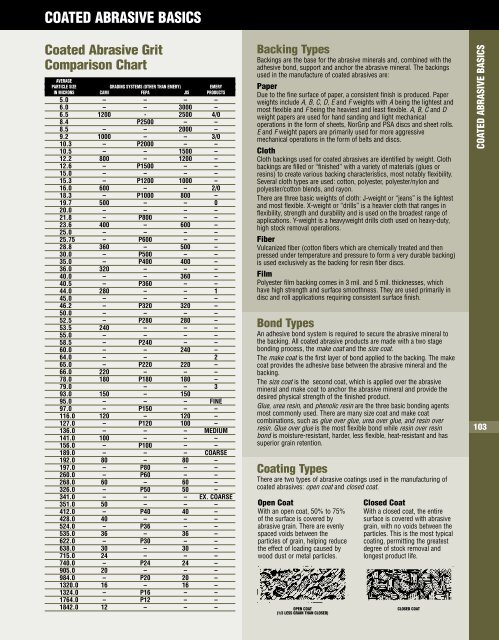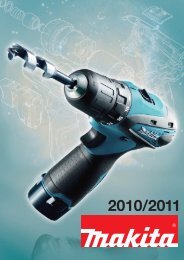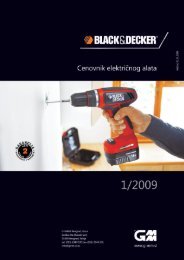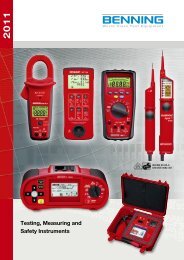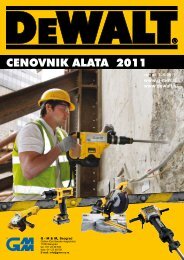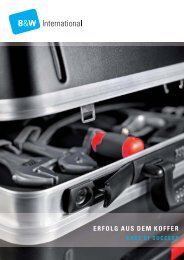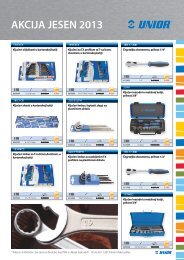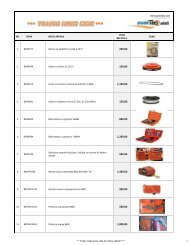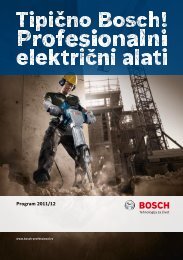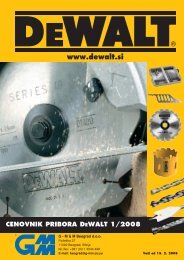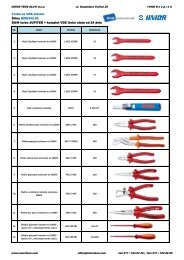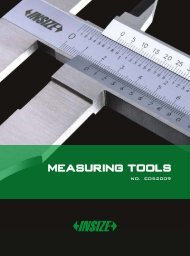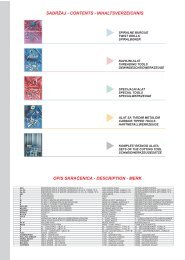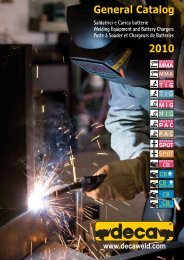Cut-off Wheels
Cut-off Wheels
Cut-off Wheels
Create successful ePaper yourself
Turn your PDF publications into a flip-book with our unique Google optimized e-Paper software.
COATED ABRASIVE BASICS<br />
Coated Abrasive Grit<br />
Comparison Chart<br />
AVERAGE<br />
PARTICLE SIZE GRADING SYSTEMS (OTHER THAN EMERY) EMERY<br />
IN MICRONS CAMI FEPA JIS PRODUCTS<br />
5.0 – – – –<br />
6.0 – – 3000 –<br />
6.5 1200 - 2500 4/0<br />
8.4 P2500 – –<br />
8.5 – – 2000 –<br />
9.2 1000 – – 3/0<br />
10.3 – P2000 – –<br />
10.5 – – 1500 –<br />
12.2 800 – 1200 –<br />
12.6 – P1500 – –<br />
15.0 – – – –<br />
15.3 – P1200 1000 –<br />
16.0 600 – – 2/0<br />
18.3 – P1000 800 –<br />
19.7 500 – – 0<br />
20.0 – – – –<br />
21.8 – P800 – –<br />
23.6 400 – 600 –<br />
25.0 – – – –<br />
25.75 – P600 – –<br />
28.8 360 – 500 –<br />
30.0 – P500 – –<br />
35.0 – P400 400 –<br />
36.0 320 – – –<br />
40.0 – – 360 –<br />
40.5 – P360 – –<br />
44.0 280 – – 1<br />
45.0 – – – –<br />
46.2 – P320 320 –<br />
50.0 – – – –<br />
52.5 – P280 280 –<br />
53.5 240 – – –<br />
55.0 – – – –<br />
58.5 – P240 – –<br />
60.0 – – 240 –<br />
64.0 – – 2<br />
65.0 – P220 220 –<br />
66.0 220 – – –<br />
78.0 180 P180 180 –<br />
79.0 – – 3<br />
93.0 150 – 150<br />
95.0 – – – FINE<br />
97.0 – P150 – –<br />
116.0 120 – 120 –<br />
127.0 – P120 100 –<br />
136.0 – – – MEDIUM<br />
141.0 100 – – –<br />
156.0 – P100 – –<br />
189.0 – – – COARSE<br />
192.0 80 – 80 –<br />
197.0 – P80 – –<br />
260.0 – P60 – –<br />
268.0 60 – 60 –<br />
326.0 – P50 50 –<br />
341.0 – – – EX. COARSE<br />
351.0 50 – – –<br />
412.0 – P40 40 –<br />
428.0 40 – – –<br />
524.0 – P36 – –<br />
535.0 36 – 36 –<br />
622.0 – P30 – –<br />
638.0 30 – 30 –<br />
715.0 24 – – –<br />
740.0 – P24 24 –<br />
905.0 20 – – –<br />
984.0 – P20 20 –<br />
1320.0 16 – 16 –<br />
1324.0 – P16 – –<br />
1764.0 – P12 – –<br />
1842.0 12 – – –<br />
Backing Types<br />
Backings are the base for the abrasive minerals and, combined with the<br />
adhesive bond, support and anchor the abrasive mineral. The backings<br />
used in the manufacture of coated abrasives are:<br />
Paper<br />
Due to the fine surface of paper, a consistent finish is produced. Paper<br />
weights include A, B, C, D, E and F weights with A being the lightest and<br />
most flexible and F being the heaviest and least flexible. A, B, C and D<br />
weight papers are used for hand sanding and light mechanical<br />
operations in the form of sheets, NorGrip and PSA discs and sheet rolls.<br />
E and F weight papers are primarily used for more aggressive<br />
mechanical operations in the form of belts and discs.<br />
Cloth<br />
Cloth backings used for coated abrasives are identified by weight. Cloth<br />
backings are filled or “finished” with a variety of materials (glues or<br />
resins) to create various backing characteristics, most notably flexibility.<br />
Several cloth types are used: cotton, polyester, polyester/nylon and<br />
polyester/cotton blends, and rayon.<br />
There are three basic weights of cloth: J-weight or “jeans” is the lightest<br />
and most flexible. X-weight or “drills” is a heavier cloth that ranges in<br />
flexibility, strength and durability and is used on the broadest range of<br />
applications. Y-weight is a heavyweight drills cloth used on heavy-duty,<br />
high stock removal operations.<br />
Fiber<br />
Vulcanized fiber (cotton fibers which are chemically treated and then<br />
pressed under temperature and pressure to form a very durable backing)<br />
is used exclusively as the backing for resin fiber discs.<br />
Film<br />
Polyester film backing comes in 3 mil. and 5 mil. thicknesses, which<br />
have high strength and surface smoothness. They are used primarily in<br />
disc and roll applications requiring consistent surface finish.<br />
Bond Types<br />
An adhesive bond system is required to secure the abrasive mineral to<br />
the backing. All coated abrasive products are made with a two stage<br />
bonding process, the make coat and the size coat.<br />
The make coat is the first layer of bond applied to the backing. The make<br />
coat provides the adhesive base between the abrasive mineral and the<br />
backing.<br />
The size coat is the second coat, which is applied over the abrasive<br />
mineral and make coat to anchor the abrasive mineral and provide the<br />
desired physical strength of the finished product.<br />
Glue, urea resin, and phenolic resin are the three basic bonding agents<br />
most commonly used. There are many size coat and make coat<br />
combinations, such as glue over glue, urea over glue, and resin over<br />
resin. Glue over glue is the most flexible bond while resin over resin<br />
bond is moisture-resistant, harder, less flexible, heat-resistant and has<br />
superior grain retention.<br />
Coating Types<br />
There are two types of abrasive coatings used in the manufacturing of<br />
coated abrasives: open coat and closed coat.<br />
Open Coat<br />
With an open coat, 50% to 75%<br />
of the surface is covered by<br />
abrasive grain. There are evenly<br />
spaced voids between the<br />
particles of grain, helping reduce<br />
the effect of loading caused by<br />
wood dust or metal particles.<br />
OPEN COAT<br />
(1/3 LESS GRAIN THAN CLOSED)<br />
Closed Coat<br />
With a closed coat, the entire<br />
surface is covered with abrasive<br />
grain, with no voids between the<br />
particles. This is the most typical<br />
coating, permitting the greatest<br />
degree of stock removal and<br />
longest product life.<br />
CLOSED COAT<br />
COATED ABRASIVE BASICS<br />
103


